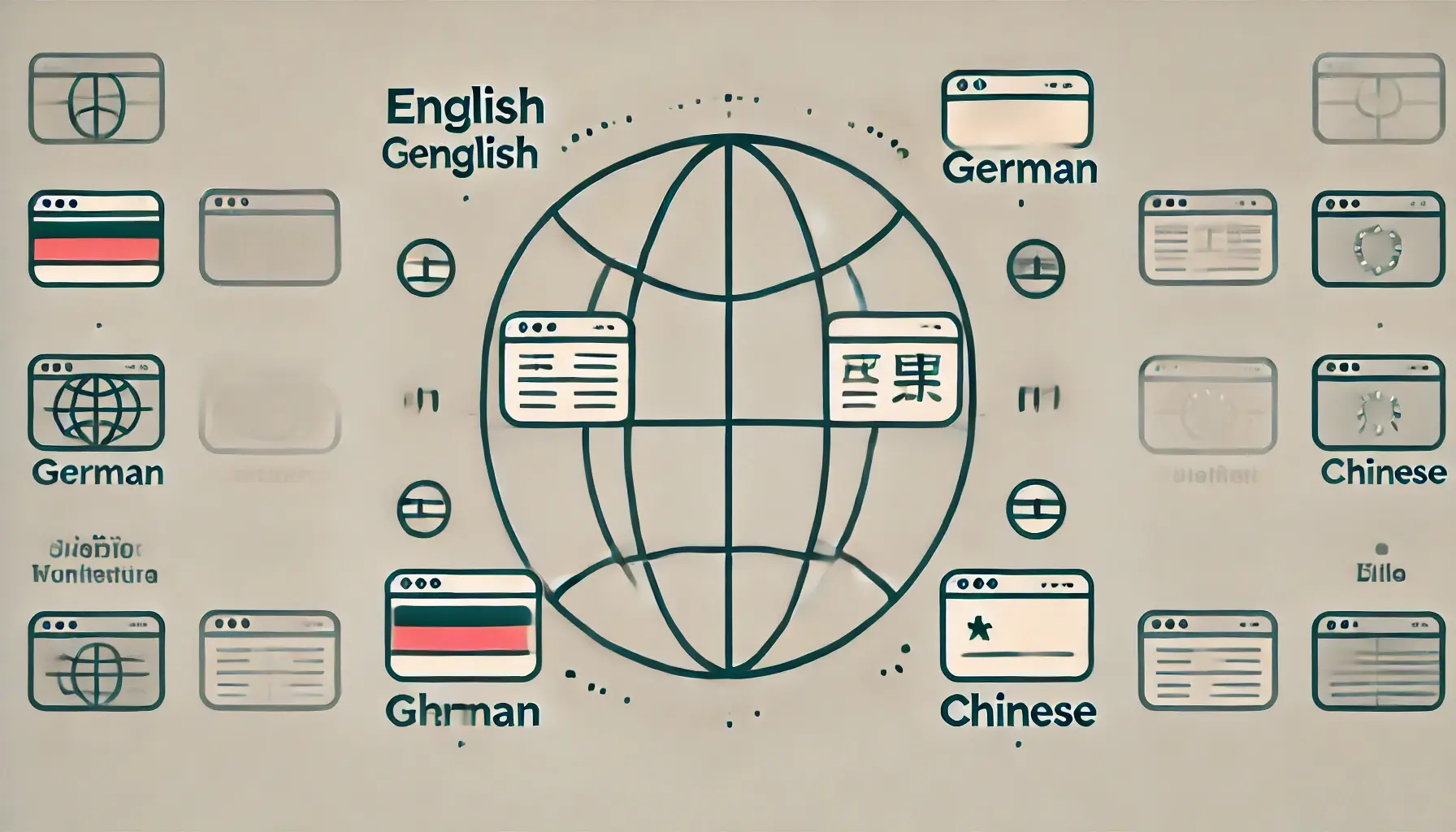Does your business aim to establish a strong online presence to succeed globally? One of the major aspects of building and maintaining a booming online presence is through Search Engine Optimization (SEO).
SEO involves optimizing your website to make it more attractive to search engines like Google. This leads to higher visibility and better rankings in search results. SEO becomes even more crucial if your business operates in multiple languages or targets a global audience.
This is where Multilingual SEO comes in. Multilingual SEO involves optimizing your website to rank well in various languages, making it easier for users worldwide to find your site when searching in their native language.
However, managing SEO for multilingual websites can be very challenging. To simplify the process, you’ll need a platform like TextUnited.
Let’s get right into it!
See also: Unlock Global Markets: Master the Art of Multilingual SEO
Challenges of Multilingual SEO and How to Overcome Them
You’re probably already wondering what challenges you may encounter while establishing a multilingual SEO strategy for your website or organization, especially if you’re new to this. The reason why you may encounter challenges is that the process can be quite complex.
The goal of optimizing your website for multiple languages is not a simple one. You may struggle with complex URL structures, accurately translating your content, and maintaining cultural appropriateness. Let’s discuss these challenges in detail.
Duplicate Content
You can encounter situations where the same or similar content appears in multiple languages or versions on your site. This is known as “duplicate content,” which is a major concern for multilingual websites.
If your site has duplicate content, search engines can penalize you, which could affect your SEO rankings.
To address this, you can use techniques like canonical tags to tell search engines which version of a page is the “main” one. This will ensure that each language version of your page is unique enough to be considered distinct by search engines.
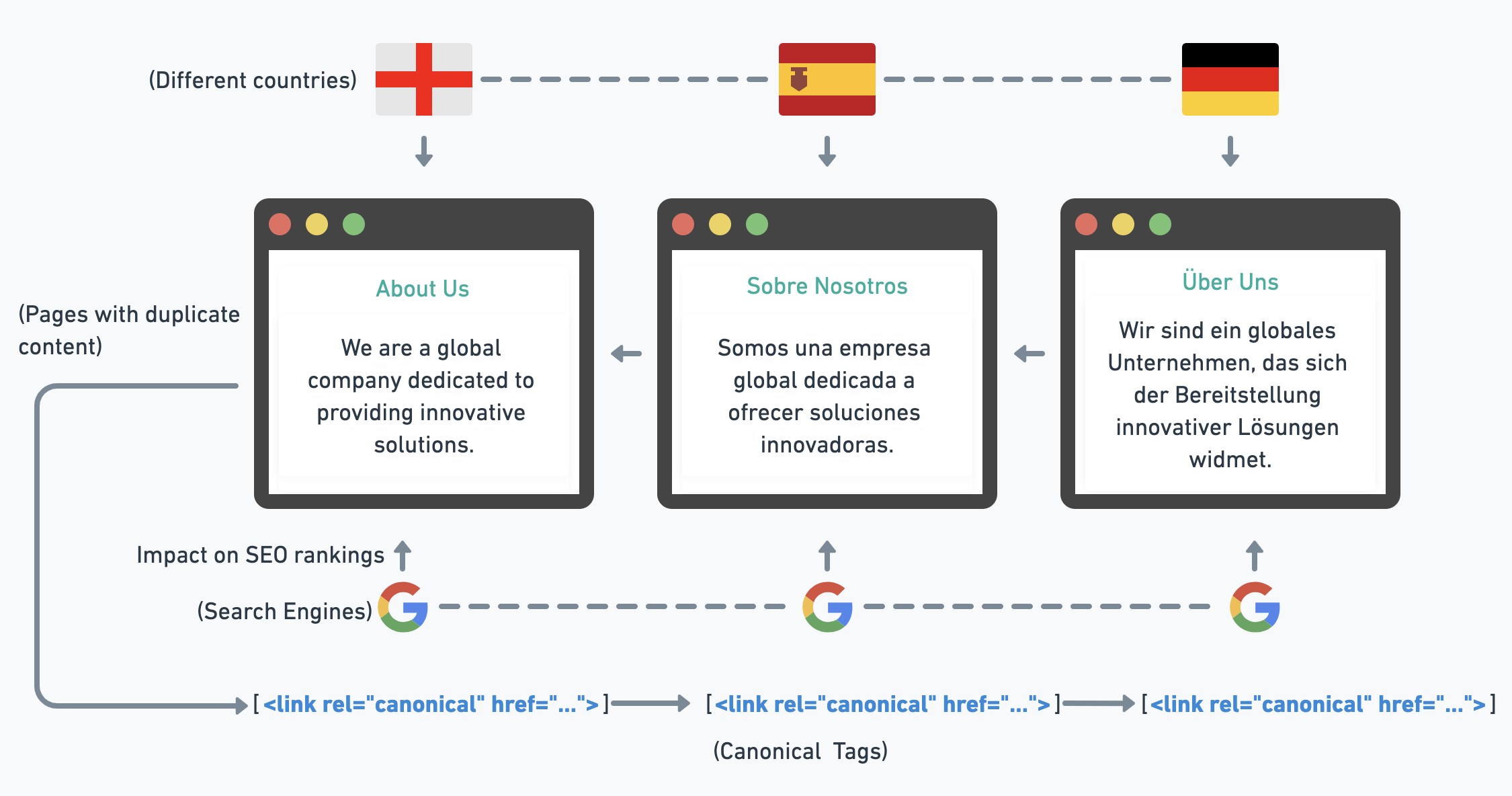 Illustration Showing How Canonical Tags Guide Search Engines to the Main Version of a Page
Illustration Showing How Canonical Tags Guide Search Engines to the Main Version of a PageStructure of URLs
Another major challenge is choosing the right URL structure for your multilingual website.
You must ensure your URLs are clear, user-friendly, and search engine-friendly. This often involves using language codes in your URLs (such as /en/ for English or /fr/ for French) to indicate the language of the content. This helps both users and search engines understand what language they’ll find on a particular page.
For example, if you’re developing a travel blog aimed at international audiences, you want to ensure that your content is easily accessible and understandable to readers from different parts of the world:
You decide to implement a clear and intuitive URL structure for your blog posts and pages. Here’s how you might structure the URLs for your “About Us” page in four different languages:
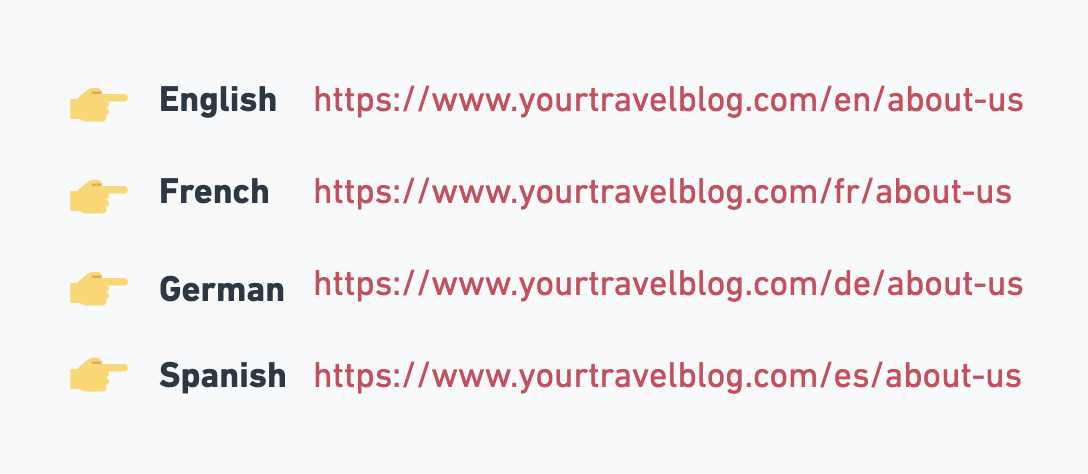
Showing the structure of the URLs
In this structure, the language code (en, fr, de, es) is included right after the base domain (yourtravelblog.com), making it immediately clear to both you and your readers which language version of the page they are viewing.
This approach not only improves the user experience by making navigation more intuitive but also supports your SEO efforts by helping search engines understand your content’s language and target audience.
Translating and Optimizing Content
Another hassle is translating content accurately while preserving its original meaning and SEO value.
Simply translating text word-for-word can lead to content that doesn’t resonate with your target audience or rank well in search engines. This is why it’s important to work with professional translators who understand both the source and target languages and can adapt the content to fit the cultural and search behaviors of the target audience.
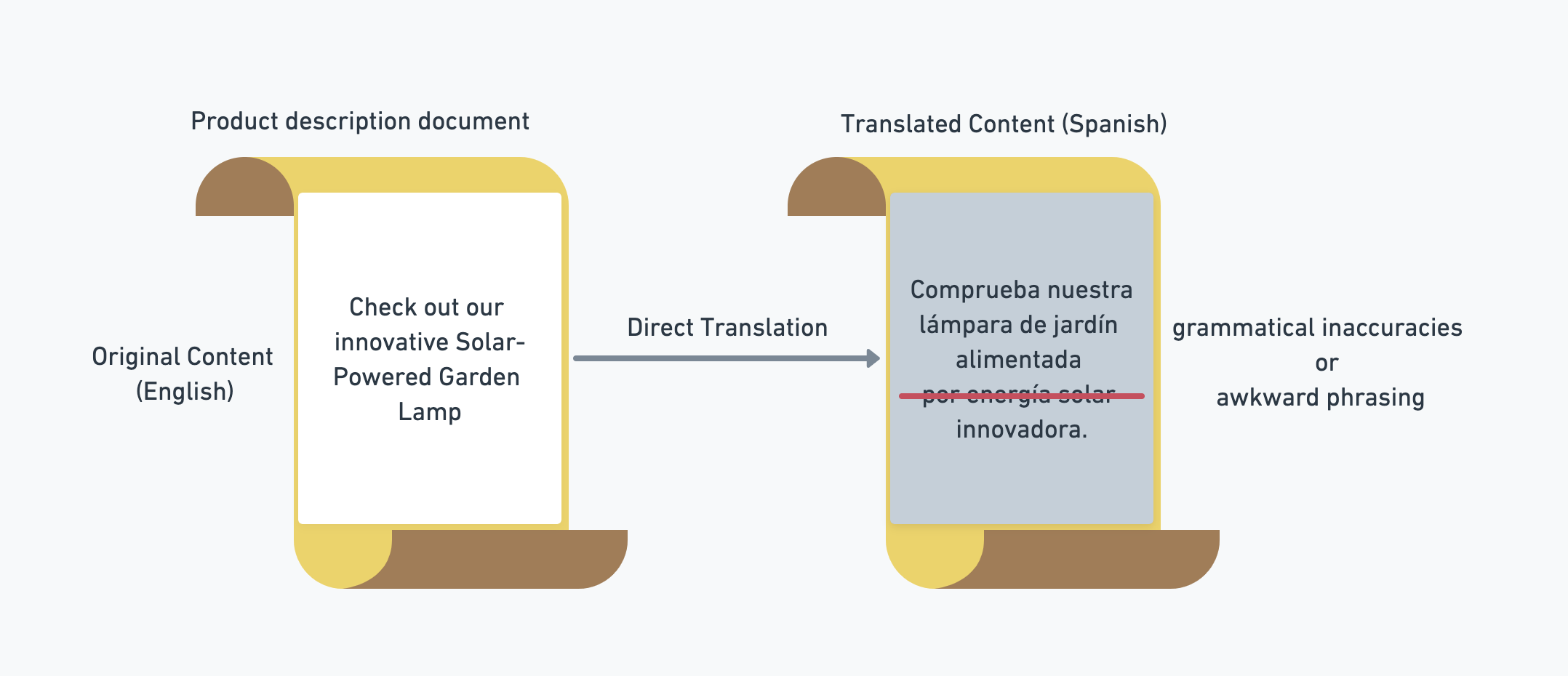
Illustration showing Inaccurate translation
Let’s say you’re launching a new eco-friendly product line and want to promote it globally. Your website must be available in multiple languages to reach a wide audience.
However, translating product descriptions directly from English to other languages without considering cultural nuances and SEO practices can result in content that is off-target.
For example, if you have a product description in English that reads:
“Introducing our revolutionary Eco-Friendly Reusable Water Bottle. Made from sustainable materials, it keeps your drinks cold for hours and reduces plastic waste.”
A direct word-for-word translation into Spanish might look like this:
“Presentamos nuestra revolucionaria botella de agua reutilizable ecológica. Hecha de materiales sostenibles, mantiene tus bebidas frías durante horas y es perfecta para reducir el desperdicio de plástico.”
While this translation is technically correct, it lacks the warmth and appeal that a native Spanish speaker might expect. A more culturally appropriate and engaging translation, considering SEO best practices, could be:
“Nuestra botella de agua reutilizable es un hito en la lucha contra el desecho de plástico. Fabricada con materiales 100% sostenibles, no solo mantendrá tus bebidas frescas durante horas, sino que también te permitirá contribuir positivamente al medio ambiente.”
This revised translation not only sounds natural to Spanish speakers but also incorporates environmental keywords that could improve the product’s visibility in search engine results among Spanish-speaking audiences.
Working with a professional translator who understands the nuances of both languages and the target market’s preferences ensures your content remains authentic, engaging, and optimized for search engines.
Multilingual vs. International SEO: What’s the Difference?
Now that you understand some of the challenges associated with establishing SEO for your multilingual websites, you can learn about the difference between Multilingual and International SEO.
If you aim to expand your business’s online presence, it’s crucial to understand the difference between these two. Although these terms are often used interchangeably, they represent distinct strategies with different focuses and implications for SEO efforts.
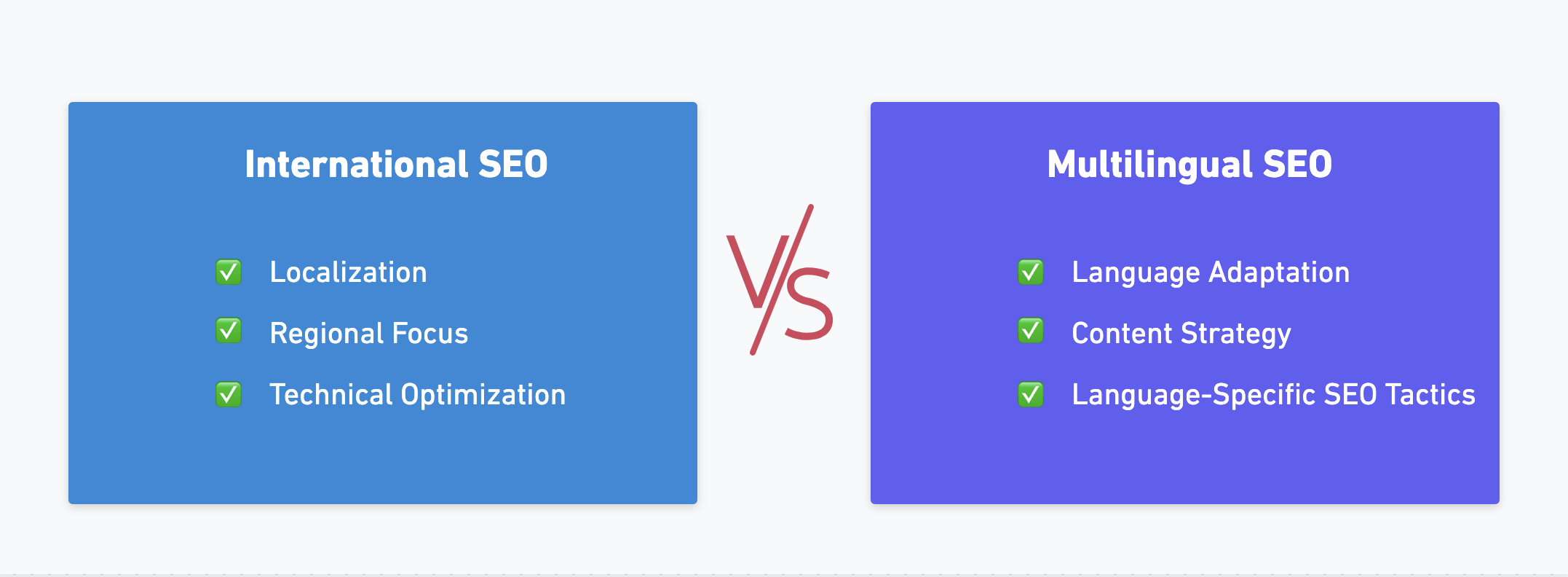
International SEO versus Multilingual SEO
International SEO
Starting with International SEO, what does this mean? If you’re seeing this for the first time, it’s about expanding your business’s reach to customers around the world.
It covers a broader scope, including not just language but also geographical location, cultural nuances, and local search engine preferences.
So, if your company is aiming to market itself globally and needs to tailor its approach to different regions, then an International SEO strategy is very relevant for you.
This approach includes several key aspects. Let’s quickly take a look at them:
- Localization: Adapting content, keywords, and user interfaces to cater to the specific needs and preferences of different markets.
- Regional Focus: Targeting specific countries or regions, taking into account the unique search behaviors and preferences of those areas.
- Technical Optimization: Ensuring your website is optimized for various search engines prevalent in different countries, such as Google in most Western countries versus Baidu in China.
Multilingual SEO
On the other hand, multilingual SEO focuses on the language aspect. It involves optimizing a website for multiple languages to ensure that the content is accessible and relevant to users speaking different languages.
If your business operates in multiple languages within the same or different countries, then this strategy is ideal for you.
It differs from International SEO in the following ways:
- Language Adaptation: This approach translates and adapts content to fit the linguistic and cultural context of different language groups.
- Content Strategy: It involves creating or modifying content to resonate with the target audience in each language, considering the nuances and idioms specific to those languages.
- Language-Specific SEO Tactics: It also involves implementing SEO strategies tailored to each language, including keyword research and optimization for languages other than English.
From all these, we can say that International SEO sets the groundwork for entering new markets by considering the broader geographical and cultural context. Meanwhile, Multilingual SEO deepens the connection with the audience by making sure content is linguistically and culturally relevant.
On a side note, if your business aims to truly resonate with a global audience, implementing both strategies is the way to go.
Why?
Because International SEO opens doors to new markets, while Multilingual SEO boosts the user experience by making your website accessible and engaging to speakers of different languages, which strengthens the bond between your brand and its audience.
Now, the big question is: how do you achieve multilingual SEO for your websites? Pause and take a moment to think. If you’re still unsure, don’t worry; we’ll cover it in the next section!
TextUnited’s Approach to Multilingual SEO
So far, you’ve learned about the challenges and approaches of implementing multilingual SEO for your websites or optimizing your websites for multiple languages.
However, dealing with these complexities on your own can be very strenuous and ineffective. That’s why you should use a platform like TextUnited. It offers a solution to your problems and helps manage the complexities of multilingual SEO.
TextUnited leverages advanced translation technologies and expert human oversight to deliver high-quality translations that improve SEO performance.
Book a demo with TextUnited now! Visit this website to get started:

Book a Demo with TextUnited
Let’s take a closer look at TextUnited’s approach and how it addresses the various challenges of multilingual SEO.
Machine Translation with Human Post-Editing
At the core of TextUnited’s approach is the combination of machine translation with human post-editing. Machine translation uses algorithms to convert text from one language to another quickly and efficiently.
However, there are situations where machines miss details or cultural nuances that are crucial for SEO optimization. That’s where human post-editing comes in.
This human post-editing process involves expert translators who review and refine the machine-generated translations. So, at the end of the day, you have a final product that is not only accurate but also culturally sensitive and optimized for search engines.
See also: Machine Translation Post-Editing. Combining Human and Machine.

Machine translation with TextUnited
Fully Human Translation
If your business needs quality translated content that resonates deeply with your target audience and, at the same time, performs well in search engine rankings, then you should definitely try out TextUnited.
Among the other services TextUnited provides is the fully human translation service. What this means is human translators are provided to translate your content and ensure that the nuances, idioms, and cultural references are accurately captured.
And of course, if your business deals with legal, medical, or creative fields, you would most likely be hell-bent on content accuracy and tone, and this service TextUnited provides can give you that level of attention to detail.
Managed Translations
We just discussed the fully human translation service that TextUnited provides, but that’s not all.
What if your business lacks the resources or expertise to manage multilingual SEO efforts internally? TextUnited still has you covered!
TextUnited provides managed translation services. This service is comprehensive, meaning it includes everything from initial consultation and project planning to execution and ongoing support.
What this means for you is that your translations will be managed by TextUnited, relieving your business from the complexity of multilingual SEO.
In other words, your business will rely on TextUnited’s expertise to handle the nuances of translation, localization, and SEO optimization. This saves you stress, especially if you’re looking for a hassle-free way to expand your business’s online presence across multiple languages while still being confident that your content will be both accurate and optimized for search engines.
Ready to Optimize Your Website’s SEO With TextUnited?
You’ve learned a lot about multilingual SEO and how it can be hassle-free and achievable with TextUnited. So, what’s next?
Take the first step towards achieving multilingual content and global success today! Don’t wait any longer to boost your business’s online presence. Experience firsthand how TextUnited’s advanced translation and localization services can transform your content, making it resonate with your global audience and boost your SEO rankings.
Start your free trial with TextUnited now by visiting the official website and signing up:

Signing up on TextUnited (Free trial)
